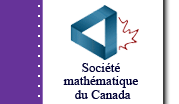Nous avons trouvé 110 articles correspondant à votre recherche.
 |
 |
 |
 |
 |
 |
|
|
| |

This article is part of the Mathematics Notes series at Washington State University. In the article, Judi and Harley start by determining the functions that map the plane back onto itself, while at the same time, mapping a specified line back onto itself and preserving the size and shape of any objects represented in the plane. These are the functions that preserve frieze patterns. The authors then look at the algebraic structure of this collection of functions under the operation of composition, show that there are only seven frieze groups, and illustrate how they are generated. Each frieze group is represented algebraically and geometrically. The article concludes with a tour of the Washington State University campus, looking at the ways in which frieze groups are exhibited and used in our immediate surroundings.
|
AUTEUR(S): Judith J. McDonald and J. Harley Weston

|
 |
|
|
| |

Gregory and Oleksandr find more compact and efficient ways to express some identities involving arcsine and arccosine that appear in the Handbook of Mathematics. The expression Gregory and Oleksandr found was used to derive their arc midpoint computation.
|
AUTEUR(S): Gregory V. Akulov and Oleksandr G. Akulov

|
 |
|
|
| |

This is a collection of Aboriginal games that teachers can use to integrate culture into Mathematics lessons. The mathematical content includes patterns and relations, probability, data management, numbers and operations, problem solving, critical thinking, and geometry. Students will have fun with the games while they apply their mathematical knowledge.
|
AUTEUR(S): Compiled by Karen Arnason, Mhairi(Vi) Maeers, Judith McDonald and Harley...

|
 |
|
|
| |

This Stewart Resource unit covers many topics some of which are basics of graphing, linear equations, characteristics of a line, arithmetic sequences and series and more. Seven sub-units with lessons are presented with objectives, evaluation ideas and procedures for each.
|
AUTEUR(S): Gale Russell

|
 |
|
|
| |

This development of the greatest common factor and least common multiple is taken from Math 101 Online an online course at the University of Regina. This resource contains a description of the gcd and lcm as well as the Euclidean Algotithm.
|
AUTEUR(S): Penny Nom

|
 |
|
|
| |

This Stewart Resource unit describes the use of manipulatives in to study lines, line segments, angles and polygons.
|
AUTEUR(S): Kathleen Bracken

|
 |
|
|
| |

In this note Gregory uses his Arc Midpoint Computation formula to devise a problem regarding riding a bicycle around the University of Victoria campus.
|
AUTEUR(S): Gregory V Akulov

|
 |
|
|
| |

This is the lead article in the eighth edition of Ideas and Resources for Teachers of Mathematics, a newsletter published by the Saskatchewan Mathematics Teachers' Society. The topic of the eighth edition of the newsletter is "Real World Problem Solving" and in this note Rick writes about discussions with three women and their "math anxiety".
|
AUTEUR(S): Rick Seaman

|
 |
|
|
| |

This one of the articles in the twelth edition of Ideas and Resources for Teachers of Mathematics, a newsletter published by the Saskatchewan Mathematics Teachers' Society. In this article Rick and Nick, faculty members at the University of Regina, present a coach's preparation for a football game as an exercise in data management.
|
AUTEUR(S): Rick Seaman and Nick Forsberg

|
 |
|
|
| |

This one of the articles in the seventh edition of Ideas and Resources for Teachers of Mathematics, a newsletter published by the Saskatchewan Mathematics Teachers' Society. The theme of the seventh edition is patterning and algebra and in this article Alain shows how experiments can be used to make connections between formulas and real life situations.
|
AUTEUR(S): Alain Gauthier

|
 |
|
|
| |

This note appears in the twelth edition of Ideas and Resources for Teachers of Mathematics, a newsletter published by the Saskatchewan Mathematics Teachers' Society. It announces a master teachin award and contains an application form.
|
AUTEUR(S): Saskatchewan Mathematics Teachers' Society

|
 |
|
|
| |

A librarian wrote to Quandaries and Queries inquiring about teaching resources for incorporating writing into mathematics. In this response Walter and Rick supply some references.
|
AUTEUR(S): Walter Whiteley and Rick Seaman

|
 |
|
|
| |

This article discusses some of the many ways in which math is used in agriculture. It considers specific agriculture processes, as well as a variety of math concepts.
|
AUTEUR(S): Natasha Glydon

|
 |
|
|
| |

Katherine Heinrich the Canadian Math Society (CMS) President (1996-98) has put together a list of possible math projects for science fairs. This list is on the CMS site. If you wish to return to Math Central after viewing her list use the Back button on your browser.
|
AUTEUR(S): Katherine Heinrich

|
 |
|
|
| |

In this note Penny look at some induction problems including some that illustrate the need for a suitable induction hypothesis and show how things can go wrong if it is not strong enough.
|
AUTEUR(S): Penny Nom

|

